Telangana TSBIE TS Inter 2nd Year Botany Study Material 5th Lesson Respiration in Plants Textbook Questions and Answers.
TS Inter 2nd Year Botany Study Material 5th Lesson Respiration in Plants
Very Short Answer Type Questions
Question 1.
Energy is released during the oxidation of compounds in respiration. How is this energy stored and released as and when it is needed?
Answer:
- Energy contained in respiratory substrates is released in a series of slow step wise reactions controlled by enzymes and stored as ATP.
- ATP is broken down whenever and wherever energy needs to be utilised.
Question 2.
Explain the term ‘Energy currency’. Which substance acts as energy currency in plants and animals?
Answer:
- ATP is broken down whenever and wherever energy needs to be utilised is cells of living organisms.
- ATP acts as energy currency in plants and animals.
Question 3.
Different substrates get oxidised during respiration. How does respiratory quotient (RQ) indicate which type of substrate i.e., carbohydrate, fat or protein is getting oxidised?
RQ = A/B
What do A and B stand for?
What type of substrates have RQ of 1, <1, >1?
Answer:
1. RQ is an index for type of substrate being used in respiration RQ = A/B, in which A stands for volume of CO2 evolved and B stands for volume of O2 consumed. Thus RQ = volume of CO2 evolved/Volume of O2 consumed.
2. RQ is 1, when carbohydrates are used as substrate. It is less than 1, when fats or proteins are used as substrate.
Question 4.
What is the specific role of F0 – F1 particles in respiration?
Answer:
- F0 is the integral membrane protein complex that forms the channel through which protons cross enter into matrix by crossing the inner membrane.
- F1 head piece is the peripheral membrane protein complex and contains the site for synthesis of ATP from ADP and inorganic phosphate.
Question 5.
When does anaerobic respiration occur in man and yeast?
Answer:
- Anaerobic respiration occurs during exercise in the muscles of man when oxygen is inadequate for cellular respiration.
- In yeast, anaerobic respiration occurs during fermentation.
![]()
Question 6.
Distinguish between obligate anaerobes and facultative anaerobes.
Answer:
1) Obligate anaerobe :
An organism that cannot grow in the presence of oxygen. It neither requires O2 to grow nor does it tolerate it.
2) Facultative anaerobe :
An organism can grow in either the presence or absence of oxygen. It does not require oxygen to grow but it does tolerate its presence.
Question 7.
Explain the economic importance of fermentation.
Answer:
- Fermentation is useful in making bread.
- It is useful for industrial production of organic acids and alcohol.
Question 8.
What is the common pathway for aerobic and anaerobic respirations? Where does it take place?
Answer:
- Glycolysis (EMP pathway) is the common pathway for both aerobic and anaerobic respirations.
- It occurs in cytoplasm of the cell and takes place is all living organisms.
Question 9.
Why are mitochondria termed as the power houses of the cell?
Answer:
- Mitochondria are found in eukaryotic cells and are seat of Krebs cycle and oxidative phosphorylation.
- They produce energy currency of the cell (ATP).
Question 10.
What is the reason for describing ATP synthesis in FQ – Fx particles of mitochondria as oxidative phosphorylation?
Answer:
- Oxygen acts as the final Hydrogen acceptor is ETS of aerobic respiration.
- Production of proton gradient and synthesis of ATP by ATP synthase in respiration are oxygen driven, hence it is called oxidative phosphorylation.
Question 11.
Which substance is known as the connecting link between glycolysis and Krebs cycle? How many carbons does it have?
Answer:
- Acetyl CoA is the connecting link between glycolysis and Krebs cycle.
- It consists of 2 carbon atoms.
![]()
Question 12.
What cellular organic substances are never used as respiratory substrates?
Answer:
Pure proteins or fats are never used as respiratory substrates.
Question 13.
Why is the RQ of fats less than that of carbohydrates?
Answer:
1. It requires more oxygen for complete oxidation, since C : O ratio in fats in very high.

Question 14.
What is meant by ‘Amphibolic pathway’?
Answer:
- The pathway involved both in catabolism and anabolism is termed as Amphibolic pathway.
- Eg. Respiratory pathway.
Question 15.
Name the mobile electron carriers of the respiratory electron transport chain in the inner mitochondrial membrane.
Answer:
- Cytochrome C that transfer electrons between complex III and IV of ETS.
- U biquinone that acts as electron carries in between complex II and III of ETS.
Question 16.
What is the final acceptor of electrons in aerobic respiration? From which complex does it receive electrons?
Answer:
- Oxygen is the final acceptor of electrons in aerobic respiration.
- It receives electrons from complex IV (cytochrome ‘c’ oxidase).
Short Answer Type Questions
Question 1.
What is meant by the statement ‘Aerobic respiration is more efficient’?
Answer:
- Aerobic respiration is the process that leads to a complete oxidation of organic substance in the presence of oxygen.
- It releases CO2, water and a large amount of energy present in the substrate.
- 686 k.cal of energy is released where as in anaerobic respiration only 56 k.Cal. is released.
- In aerobic respiration 36 ATP molecules are formed. Where as in anaerobic respiration only 2 ATP molecules are formed.
Question 2.
Pyruvic acid is the end product of glycolysis. What are the three metabolic fates of pyruvic acid under aerobic and anaerobic conditions?
Answer:
The fate of pyruvate depends upon the availability of O2 and the type of organism. The three metabolic fates of pyruvic acid are
- lactic acid fermentation
- alcoholic fermentation under anaerobic condition and
- aerobic respiration under aerobic condition.
![]()
Question 3.
The energy yield in terms of ATP is higher in aerobic respiration than during anaerobic respiration. Why is there anaerobic respiration even in organisms that live in aerobic condition like human beings and angiosperms?
Answer:
- Under the conditions of oxygen scarcity anaerobic respiration takes place in organism that live in aerobic conditions.
- For example because Muscle tissue under intense use muscle demands too much energy (ATP) and consume much more Oxygen to produce that energy. This high consumption leads to oxygen scarcity and the muscle cells begin to make lactic acid by anaerobic respiration to fulfill their energy needs.
- The first cells on this planet lived in an atmosphere that lacked O2. Even today all living organisms retain the enzymatic machinery to partially oxidise glucose without the help of oxygen during glycolysis.
Question 4.
Oxygen is an essential requirement for aerobic respiration but it enters the respiratory process at the end. Discuss.
Answer:
- Although the aerobic process of respiration takes place only in the presence of oxygen, the role of oxygen is limited to the terminal stage of the process.
- The presence of oxygen is vital, since it drives the whole process by removing hydrogen from the system.
- Oxygen acts as the final hydrogen acceptor.
- In respiration, it is the energy of oxidation-reduction utilised for Phosphorylation. It is for this reason that the process is called oxidative phosphorylation.
Question 5.
Respiration is an energy releasing and enzymatically controlled catabolic process which involves a stepwise oxidative breakdown of organic substances? Inside living cells.
In this statement about respiration, explain the meaning of i) step wise oxidative breakdown ii) organic substance (used as substrates).
Answer:
i) a) Respiration involves a stepwise oxidative breakdown of organic substances.
b) In the process of aerobic respiration it is divided into 4 phases. They are Glycolysis, TCA cycle, Electron Transport System and Oxidative Phosphorylation.
c) It is generally assumed that the process of respiration and production of ATP in each phase takes place in a stepwise manner.
d) The product of one pathway forms the substrate of the other pathway.
e) Various molecules produced during respiration are involved in other biochemical processes.
f) The respiratory substrate enters and withdraws from pathway.
g) ATP gets utilised whenever required and enzymatic rates are generally controlled.
h) Stepwise breakdown of organic substances makes the system more efficient in extracting and storing energy.
ii) Usually carbohydrates, glucose are oxidised to release energy but proteins, fats and even organic acids can be used as respiratory substrates in some plants under certain conditions.
Question 6.
Comment on the statement – Respiration is an energy producing process but ATP is used in some steps of the process.
Answer:
- Though respiration is an energy producing process ATP is utilised in two steps during glycolysis.
- First in the conversion of glucose into glucose 6 phosphate.
Glucose + ATP → Glucose 6 phosphate + ADP. - Second in the conversion of fructose 6 phosphate into Fructose 1-6 bisphosphate.
Fructose 6 phosphate + ATP → fructose 1, 6 bisphosphate + ADP.
![]()
Question 7.
Explain briefly the process of glycolysis.
Answer:
Glycolysis occurs in the cytoplasm of all living organisms. In this process, glucose undergoes partial oxidation to form two molecules of pyruvic acid. The scheme of glycolysis was given by Gustav Embden, Meyerhof and J. Parnas and is often referred to as the EMP pathway.
In glycolysis, a chain of ten reactions, under the control of different enzymes takes place to produce pyruvate from glucose. They are
1) Phosphorylation :
Glucose is phosphorylated to give rise to glucose 6-phosphate one ATP is utilised.
![]()
2) Isomerisation :
Glucose 6 phosphate converts into isomer fructose 6 phosphate in the presence of phosphohexose isomerase.
![]()
3) Phosphorylation :
The enzyme phosphofructokinase uses another ATP molecule to transfer a phosphate group to fructose 1, 6 biphosphate.

4) Cleavage :
The enzyme aldolase splits fructose 1,6 bisphosphate into two sugars that are isomers to each other. They are Glyceraldehyde 3 phosphate & Dihydroxy acetone phosphate (DHAP).

5) Isomerisation :
Enzyme Triose phosphate isomerase rapidly inter-converts the molecules of DHAP and G3P.

6) Oxidation :
Glyceraldehyde-3-phosphate undergoes oxidation and phosphorylation in the presence of Glyceraldehyde dehydrogenase resulting in the dehydrogenase formation of 1, 3 bisphosphoglyceric acid and NADH.

7) Dephosphorylation :
Enzyme phosphoglycerokinase catalyses the dephosphorylation of 1, 3 bisphosphoglyceric add resulting 3 PGA. ATP is formed.
![]()
8) Intramolecular shift (Isomerisation) :
Enzyme phosphoglyceromutase transfers phosphate group from 3-carbon position to 2-carbon position resulting 2 PGA.
![]()
9) Dehydration :
The enzyme enolase catalyses the removal of one water molecule from 2 PGA resulting in PEP.
![]()
10) Dephosphorylation :
Phosphoenol pyruvic acid undergoes dephosphorylation in the presence of enzyme pyruvic kinase and results in the formation of pyruvic acid ATP is formed.
![]()
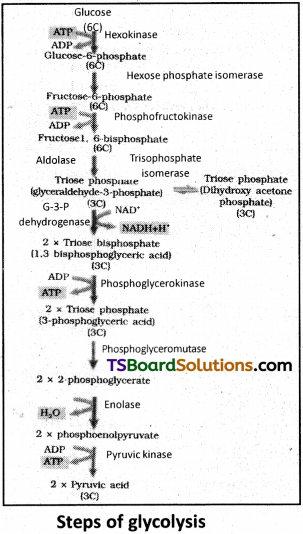
Question 8.
Why is the respiratory pathway referred to as an amphibolic pathway? Explain.
Answer:
a) Fatty acids would be broken down to acetyl CoA before entering the respiratory pathway when it is used as a substrate. But when the organism needs to synthesise fatty acids, acetyi CoA would be withdrawn from the respiratory pathway for it. Hence the respiratory pathway acts as both breakdown and the synthesis of fatty acids.
b) Similarly during the breakdown and the synthesis of protein too, respiratory intermediates forms the link.
c) The breaking down process within the living organism constitute catabolism, which synthesis is anabolism.
d) Because the respiratory pathway is involved in both anabolism and catabolism, it would be better to consider the respiratory pathway as an amphibolic pathway rather than as a catabolic one.
Question 9.
We commonly call ATP the energy currency of the cell. Can you think of some other energy carriers present in the cell? Name any two.
Answer:
- NADH and FADH2
- Oxidation of one molecule of NADH gives rise to 3 molecules of ATP.
- Oxidation of one molecule of FADH2 give rise to 2 molecules of ATP.
- This takes place in electron transport system for mitochondria.
Question 10.
ATP produced during glycolysis is a result of substrate level phosphorylation. Explain.
Answer:
Substrate level phosphorylation is a type of metabolic reaction that results in the formation of ATP by the direct transfer and donation of phosphate group to ADP. This occurs twice in Glycolysis.
- 1, 3 bis phospho glyceric acid form 3 phosphoglyceric acid. The enzyme phosphoglycero kinase, catalyses the phosphorylation. ADP molecule accepts the phosphate released in this reaction and gets converted into ATP.
- Phosphoenol pyruvic acid undergo dephosphorylation in the presence of the enzyme pyruvic kinase and results in the formation of pyruvic acid. ADP is converted to ATP.
Question 11.
Do you know of any step in Krebs cycle where there is a substrate level phosphorylation? Explain.
Answer:
In Krebs cycle, Succinyl coenzyme A splits into succinic acid and co-enzyme A by the catalytic activity of ‘Succinic acid thiokinase’. The energy released in this reaction is utilized to form ATP from ADP and inorganic phosphate (Pi). Because ATP formation is linked directly to conversion of substrate, this reaction is an example of substrate level phosphorylation.

![]()
Question 12.
When a substrate is being metabolised. Why doesn’t all the energy that is produced get released in one step ? Instead it is released in multiple steps. What is the advantage of step wise release of energy?
Answer:
- The stepwise release of chemical bond energy enables the cell to utilize that energy in ATP synthesis.
- It minimises the wastage of energy.
- It keeps the temperature of the cell low to prevent its burning.
- The activities of enzymes for different steps of respiration can be controlled.
- The intermediates of respiratory pathway can be used for the synthesis of other biomolecules.
Thus stepwise release of energy makes the system more efficient in extracting and storing energy.
Question 13.
Respiration requires O2. How did the first cells on earth manage to survive in an atmosphere that lacked oxygen?
Answer:
The first cells on earth manage to survive in an atmosphere that lack oxygen are anaerobic bacteria. The facultative anaerobic organism is an organism usually bacterium, that makes ATP by aerobic respiration if oxygen is present but is also capable of switching to fermentation under anaerobic conditions. Thus facultative anaerobes is an organism that can grow in either the presence or absence of oxygen. It does not require O2 to grow but it does tolerate its presence. An obligate anaerobe is an organism that cannot grow in the presence of organism. It neither require O2 to grow nor does it tolerate it.
In any case, all living organisms remain the enzymatic machinery to partially oxidise glucose without the help of oxygen.
Question 14.
The energy yield in terms of ATP is higher in aerobic respiration than during anaerobic respiration. Explain.
Answer:
- The energy yield in terms of ATP during aerobic respiration is 38 ATP molecules.
- Glucose molecule gets completely oxidised in the presence of Oxygen.
C6H12O6 + 6O2 → 6 CO2 + 6 H2O + energy - Aerobic respiration involves Glycolysis, Krebs cycle and electron transport. 2 ATP molecules are utilised during Glycolysis. Hence net gain in aerobic respiration is 36 ATP molecules.
- The energy yield in terms of ATP during an aerobic respiration is only 2 ATP molecules. It involves Glycolysis and Fermentation Glucose molecule gets incomplete oxidation in the absence of oxygen.
C6H12O6 → CO2 + Ethyl alcohol + Energy
Question 15.
RUBP carboxylase, PEPase, pyruvate dehydrogenase ATPase, cytochrome oxidase, Hexokinase, Lactic dehydrogenase.
Select the enzymes from the list above which are involved in
a) Photosynthesis
b) Respiration
c) Both photosynthesis and respiration.
Answer:
a) Enzymes in Photosynthesis : RUBP caboxylase, PEPase.
b) Enzymes in Respiration : Lactic dehydrogenase, Pyruvic dehydrogenase, Hexokinase, Cytochrome oxidase.
c) Enzymes in both photosynthesis and respiration : ATPase.
Question 16.
How does a tree trunk exchange gases with the environment although it lacks stomata?
Answer:
In stems, the living cells are organised in thin layers inside and beneath the bark. They also have openings called lenticels. The cells in the interior are dead and provide only mechanical support. Thus, most cells of a plant have at least a part of their surface in contact with air. This is also facilitated by the loose packing of parenchyma cells in leaves, stems and roots, which provide an interconnected network of air spaces.
Question 17.
Write about two energy yielding reactions of glycolysis.
Answer:
1) Phosphoglycerokinase enzyme catalyses the 1, 3 – bisphosphoglyceric acid resulting in the formation of 3-phosphoglyceric acid. ADP molecule accepts the phosphate released in this reaction and get converted into ATP. This process of ATP is known as substrate level phosphorylation.
phosphoglycerokinase
![]()
2) In the final step of glycolysis, phosphoenol pyruvic acid undergoes dephosphorylation in the presence of enzyme ‘pyruvic kinase’ and results in the formation of pyruvic acid. ADP is converted into ATP. This is also substrate level phosphorylation.
![]()
Question 18.
Name the site(s) of pyruvate synthesis. Also write the chemical reaction wherein pyruvic acid dehydrogenase acts as a catalyst.
Answer:
Sites of pyruvate are Cytosol
Pyruvate which is formed by the glycolytic catabolism of carbohydrates in the cytosol, after entering into mitochondrial matrix, undergoes oxidative decarboxylation by a complex set of reactions catalysed by pyruvic dehydrogenase. The reactions catalysed by pyruvate dehydrogenase require the participation of several coenzymes, including NAD+ and coenzyme A.

Question 19.
Mention the important series of events of aerobic respiration that occur in the matrix of the mitochondrion as well as the one that takes place in the inner membrane of the mitochondrion.
Answer:
- The important events that occur in the matrix of mitochondrion is TCA cycle or Krebs cycle or citric acid cycle.
- During citric acid cycle complete oxidation of pyruvate by the stepwise removal of all the hydrogen atoms leavings three molecules of CO2, Eight molecules of NADH + H+ and two molecules of ATP are formed.
- The important events that takes place in the inner membrane of the mitochondrion is Electron Transport System (ETS) and Oxidative Phosphorylation.
- During electron transport system the passing one of the electrons removed as part of the hydrogen atoms to molecules O2 with simultaneous synthesis of ATP takes place.
![]()
Question 20.
The respiratory pathway is believed to be a catabolic pathway. However, the nature of TCA cycle is amphibolic. Explain.
Answer
- Respiration has been considered as catabolic process and the respiratory pathway as a catobolic pathway.
- Fatty acids would be broken down to acetyl CoA before entering the respiratory pathway when it is used as a substrate. But when the organism needs fatty acids, acetyl CoA would be withdrawn from the respiratory pathway for it. Thus the respiratory pathway comes into the picture for both during the breakdown and synthesis of fatty acids.
- Similarly during the breakdown and synthesis of proteins too, respiratory intermediates form the link.
- The breakdown process within the living organism is called catabolism. The synthesis of his process is called anabolism.
- Thus the respiratory pathway includes both anabolism and catabolism. Hence it is better to consider respiration as an amphibolic pathway rather than catabolic one.
Question 21.
The net gain of ATP for the complete aerobic oxidation of glucose is 36. Explain.
Answer:
ATP produced during complete aerobic oxidation of one molecule of glucose is as follows.
I) Glycolysis:
i) ATP produced by substrate level phosphorylation
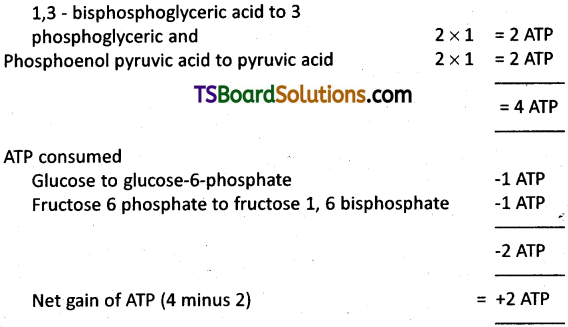
ii) From NADH generated in glycolysis

II) Oxidative decarboxylation of Pyruvic acid
![]()
III) Krebs’s Cycle
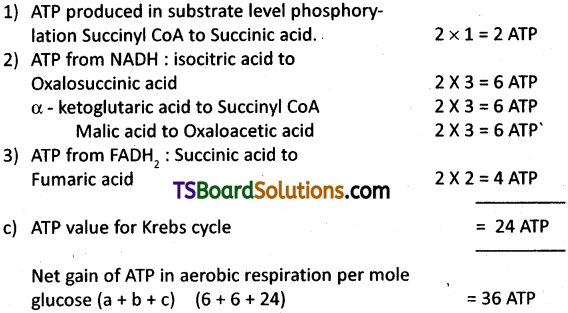
Long Answer Type Questions
Question 1.
In the following flow chart, replace the symbols a, b, c and d with appropriate terms. Briefly explain the process and give any two applications of it.
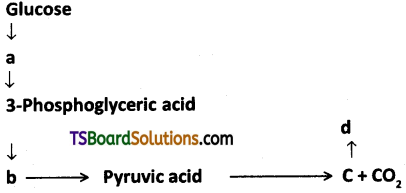
Answer:
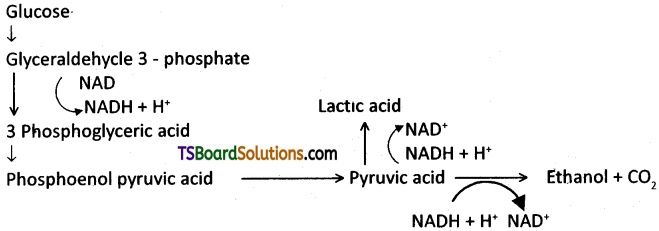
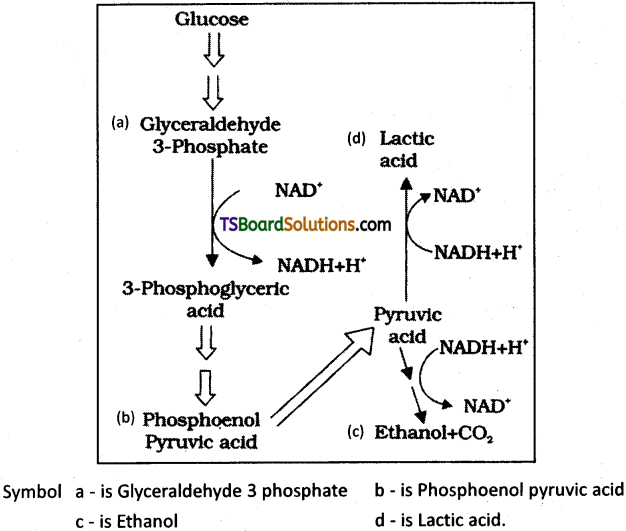
This process is Fermentation.
In fermentation, the pyruvic acid the incomplete oxidation of glucose is achieved under anaerobic conditions by sets of reactions, where pyruvic acid is converted to C02 and ethanol. In some bacteria lactic acid is formed from pyruvic acid.
Applications :
- Fermentation is used for preparing alcohol by using yeast cell.
- In animal cells, like muscles during exercise when oxygen is inadequate for cellular respiration, pyruvic acid.is reduced to lactic acid by lactate dehydrogenase.
Question 2.
Explain Mitchell’s chemiosmosis in relation to oxidative phosphorylation.
Answer:
The synthesis of ATP in respiration is associated with the consumption of oxygen, hence it is referred as oxidative phosphorylation. The mechanism of mitochondrial ATP synthesis can be explained by Mitchell’s chemiosmosis. The transfer of electrons from NADH or FADH to oxygen through electron transport system results in proton transfer from matrix to inner membrane space of mitochondria. Due to this, proton concentration gradient is established across the inner mitochondrial membrane (more number of H+ on inner membrane space side and less on the matrix side).
The inner membrane Of mitochondria is virtually impermeable to protons and thus prevents the return of proton into the matrix.
However the ATP synthase (complex V) consists of the major components F1 and F0 .
F0 is the integral membrane protein complex that forms the channel through which protons cross the inner membrane.
F1 head piece is a peripheral membrane protein complex and contains the site for the synthesis of ATP from ADP and inorganic phosphate.
When H+ move down the gradient, energy is released some amount of energy helps in combining ADP and iP leading to the form of ATP. The energy of 3H+ moving down the potential gradient is sufficient to form one ATP molecule.
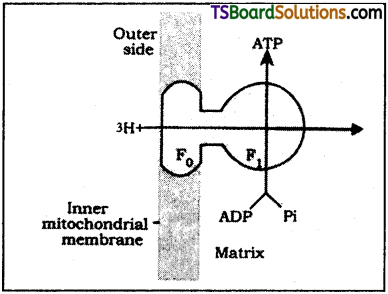
Diagramatic presentation of ATP synthesis in mitochondria
![]()
Question 3.
Oxygen is critical for aerobic respiration. Explain its role with respect to ETS.
Answer:
The energy stored in NADH + H+ and FADH2 are oxidised through electron transport system. The electrons are passed on to O2 resulting in the formation of H2O.
The metabolic pathway through which an electron passes from one carrier to another is called the Electron Transport System (ETS). It is present in the inner mitochondrial membrane.
- Electrons from NADH produced in the mitochondrial matrix during the citric acid cycle are oxidised by an NADH dehydrogenase (complex I) and the electrons are transferred to ubiquinone located within the inner membrane.
- Ubiquinone also receives reducing equivalents via FADH2 (complex II) that is generated during oxidation of succinate in the citric acid cycle.
- The reduced ubiquinone is then oxidised with the transfer of electrons to cytochrome c via cytochrome bcx complex (Complex III).
- Cytochrome c is a small protein attached to the outer surface of the inner membrane and acts as a mobile carrier for the transfer of electrons between complex III and IV.
- Complex IV refers to cytochrome c oxidase complex containing cytochromes a and a3 and two copper centres.
When the electrons pass from one carrier to another via complex I to IV in the electron transport chain, they are coupled to ATP synthase (complex V) for the production of ATP from ADP and inorganic phosphate.
The number of ATP molecules synthesised depends upon the nature of electron donor. Oxidation of one molecule of NADH gives rise to 3 molecules of ATP, while that of one molecule of FADH2 produces 2 molecules of ATP. Although the aerobic process of respiration takes place only in the presence of oxygen, the role of oxygen is limited to the terminal stage of the process. The presence of oxygen is vital, since it drives the whole process by removing hydrogen from the system.
Oxygen acts as the final hydrogen acceptor. Unlike photophosphorylation where it is the light energy that is utilised for the production of proton gradient required for phosphorylation.
In respiration it is the energy of oxidation – reduction utilised for the same process. It is for this reason that the process is called oxidative phosphorylation.
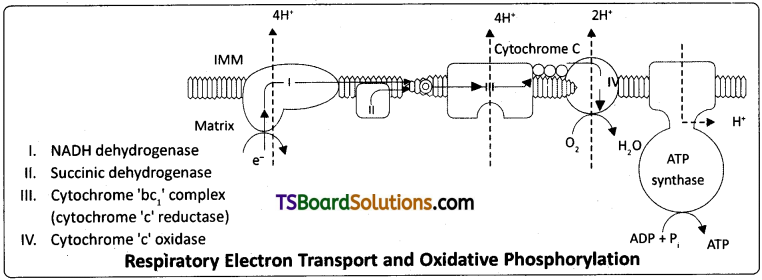
Question 4.
Enumerate the assumptions that we undertake in making the respiratory balance sheet. Are these assumptions valid for a living system ? Compare fermentation and aerobic respiration in this context.
Answer:
It is possible to make calculations of the net gain of ATP for every glucose molecule oxidised; but in reality this can remain only a theoretical exercise. These calculations can be made only on certain assumptions. These assumptions are :
- There is a sequential, orderly pathway functioning, with one substrate forming the next and with glycolysis, TCA cycle and ETS pathway following one after another.
- The NADH synthesised in glycolysis is transferred into the mitochondria and undergoes oxidative phosphorylation.
- None of the intermediates in the pathway are utilised to synthesise any other compound.
- Only glucose is being respired – no other alternative substrates are entering in the pathway at any of the intermediary stages.
These kinds of assumptions are not really valid in a living system because (1) all pathway work simultaneously and do not take place one after another. (2) Substrates enter the pathways and are withdrawn from it as and when necessary. (3) ATP is utilised as and when needed. (4) Enzymatic rates are controlled by multiple means.
Comparison of fermentation and aerobic respiration :
- Fermentation accounts for only a partial breakdown of glucose whereas in aerobic respiration glucose completely degraded to CO2 and H2O.
- In fermentation there is a net gain of only two molecules of ATP for each molecule of glucose degraded to pyruvic acid whereas many more molecules of ATP are generated under aerobic conditions.
- NADH is oxidised to NAD+ rather slowly in fermentation; however the reaction is very vigorous in the case of aerobic respiration.
Question 5.
Give an account of glycolysis. Where does it occur? What are the end products? Trace the fate of these products in both aerobic and anaerobic respiration. [Mar. ’20, 18, May ’17]
Answer:
Glycolysis occurs in the cytoplasm. The end product of glycolysis is pyruvic acid.
Glycolysis is the process in which glucose undergoes partial oxidation to form two molecules of pyruvic acid. It is as follows.
1) In the first of glycolysis, a phosphate group is added to glucose molecule in the formation of glucose-6-phosphate. ATP is utilised. This reaction is catalysed by hexokinase enzyme.
![]()
2) Phosphohexokinase enzyme catalyses the conversion of glucose-6-phosphate to its isomer fructose-6-phosphate.
![]()
3) Fructose-6-phosphate undergoes phosphorylation resulting Fructose-1, 6 bisphosphate. In this step ATP is utilised. This reaction is done by enzyme phosphofructokinase.
![]()
4) Fructose 1-6 bisphosphate with the help of enzyme aldolase splits into 2 molecules. They are glyceraldehyde 3 phosphate and dihydroxyacetone phosphate (DHAP).

5) Among the two trioses, only Glyceraldehyde 3 phosphate directly participates in the subsequent reactions.
On the other hand, dihydroxyacetone phosphate gets converted into glyceraldehyde- 3-phosphate in the presence of triose phosphate isomerase and can participate in the next reaction of glycolysis.
![]()
6) Glyceraidehyde-3-phosphate undergoes oxidation as well as phosphorylation in the presence of glyceraldehyde 3 phosphate dehychoganase resulting in the formation of 1-3-bisphospho glyceric acid and NADH.

7) Phosphoglycerokinase enzyme catalyses the dephosphorylation of 1,3 bisphosphoglyceric acid resulting in the formation of 3 phosphoglyceric acid. ADP molecule accepts the phosphate released in this reaction and gets converted into high energy compound ATP. This process of formation is known as substrate level phosphorylation.
![]()
8) Phosphoglyceromutase enzyme catalyses the transfer of phosphate group from 3-carbon position of 3 PGA to 2-carbon position leading to the formation of 2PGA.
![]()
9) The enzyme enolase catalyses the removal of one water molecule from 2-phospho- glyceric acid resulting in the formation of phosphoenol pyruvic acid.
![]()
10) Phosphoenol pyruvic acid undergoes dephosphorylation in the presence of the enzyme pyruvic kinase and results in the formation of pyruvic acid. ADP is converted to ATP. This is substrate level of ![]()
Fate of Pyruvic acid :
The ultimate fate of pyruvic acid which is an end product of glycolysis depends upon the availability of oxygen. In the presence of oxygen it is completely oxidized into C02 and H20. If oxygen is not available, the pyruvic acid is converted to ethyl alcohol or other organic substances by fermentation during anaerobic respiration.
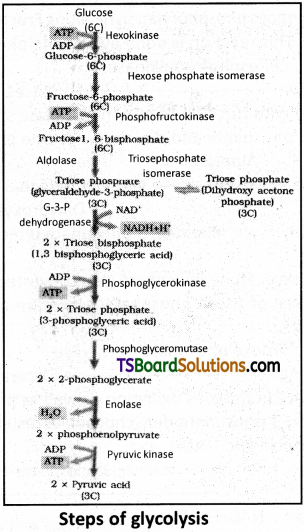
Question 6.
Explain the reactions of Kreb’s cycle.
Answer:
The reaction sequence of Kreb’s cycle is as below.
1. Condensation :
Acetyl co-enzyme A condenses with oxaloacetic acid and results in the formation of citric acid and co-enzyme A. This condensation reaction is catalysed by the enzyme ‘citric synthetase.’
![]()
2. Dehydration :
The enzyme ‘aconitase’ catalyses the removal of one molecule of water from citric acid leading to the formation of cis-aconitic acid.
![]()
3. Hydration :
Addition of one molecule of water is done in the presence of aconitase. Cis-aconitic acid forms Isocitric acid.
![]()
4. Oxidation -1 :
Isocitric acid undergoes dehydrogenation (oxidation) in the presence of ‘isocitric dehydrogenase’ enzyme, leading to the formation of oxalosuccinic acid. In this reaction NAD is reduced to NADH + H+.
![]()
5. Decarboxylation :
Oxalosuccinic acid releases one molecule of CO2 in the presence of oxalosuccinic decarboxylase enzyme and forms a – Ketoglutaric acid.

6. Oxidation – II :
α-ketoglutaric acid undergoes oxidation (dehydrogenase) decarboxylation and condensation with one molecule of CoA leading to the formation of succinyl coenzyme A.

7. Cleavage :
Succinyl coenzyme A splits into succinic acid and coenzyme A by the enzyme activity of succinic acid thiokinase. Energy released in this reaction is utilised to form ATP from ADP and inorganic phosphate.
![]()
8. Oxidation III :
Succinic acid then undergoes oxidation and forms Fumeric acid. Instead of NAD+, FAD serves as hydrogen acceptor in this reaction. Therefore FAD is reduced to FADH2. The enzyme which catalyses this reaction is known as succinic dehydrogenase.

9. Hydration :
The enzyme Fumerase mediates the addition of one water molecule to fumaric acid and leads to the formation of malic acid.

10. Oxidation IV :
In the presence of Malic dehydrogenase, Malic acid releases two hydrogen atoms and gives rise to oxaloacetic acid. In this step NAD+ acts as hydrogen acceptor and is converted into NADH + H+.

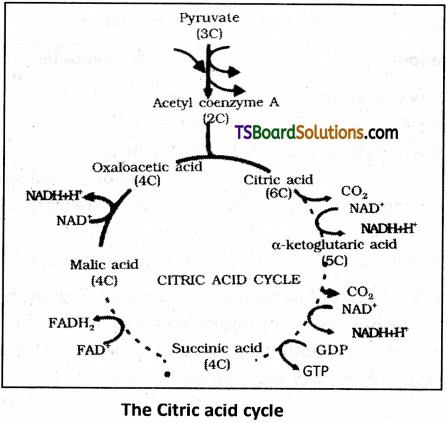
Intext Question Answers
Question 1.
Differentiate between
a) Respiration and Combustion
b) Glycolysis and Krebs cycle
c) Aerobic respiration and Fermentation
Answer:
a) Differences between Respiration and combustion :
| Respiration | Combustion |
| 1. Respiration occurs in living cells. | 1. Combustion does not occur in living cells. |
| 2. Energy is liberated in small quantities. | 2. Unlimited energy in liberated once during combustion. |
| 3. The liberated energy is stored in ATP molecules. | 3. No energy is stored during combustion. So lot of it is wasted. |
b) Differences between Glycolysis and Kreb’s cycle :
| Glycolysis | Krebs Cycle |
| 1. Glycolysis occurs in cytoplasm of the cell. | 1. Krebs cycle occurs in mitochondria. |
| 2. No generation of CO2 but consump-tion of 2 ATP under aerobic and anaerobic condition. | 2. Generation of C02 and no consumption of ATP under aerobic condition. |
| 3. End product is 2 molecules of pyruvic acid. | 3. End products are CO2 and H2O with release of more energy. |
| 4. Net gain of 8 ATP molecules per glucose molecule. | 4. Net gain of 30 ATP molecules per glucose molecule. |
c) Differences between Aerobic respiration and Fermentation.
| Aerobic respiration | Fermentation |
| 1. Occurs in majority of organisms. | 1. Occurs in yeast & bacteria. |
| 2. Occurs in the presence of O2 | 2. No need of O2 |
| 3. Complete oxidation of glucose occurs. | 3. Incomplete oxidation of glucose occurs under anaerobic condition. |
| 4. End products are energy CO2 and water. | 4. End products are CO2 and ethanol alcohol. |
| 5. Several enzymes are required. | 5. Few enzymes are required. |
![]()
Question 2.
What are respiratory substrates? Name the most common respiratory substrate.
Answer:
The compounds that are oxidised during respiration are known as respiratory substrate. The most common respiratory substrate is glucose. Usually carbohydrates are oxidised to release energy but proteins, fats and even organic acids can be used as respiratory substrate.
Question 3.
Give the schematic representation of glycolysis.
Answer:
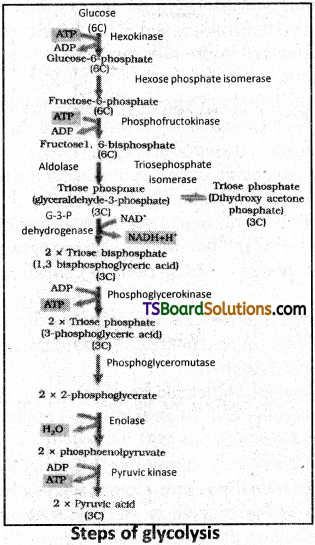
Question 4.
What are the main steps in aerobic respiration ? Where does it take place?
Answer:
The main steps in aerobic respiration are glycolysis, Krebs cycle, electron transport system and oxidative phosphorylation.
Glycolysis occurs in the cytosol of the cell, Krebs cycle occurs in the matrix of mitochondrion. Electron transport system and oxidative phosphorylation takes palce in the inner membrane of mitochondria.
Question 5.
Give the schematic representation of an overall view of Krebs cycle.
Answer:
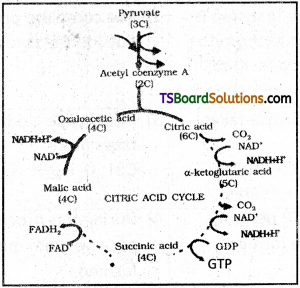
Question 6.
Explain ETS.
Answer:
The metabolic pathway through which an electron passes from one carrier to another is called the electron transport system. It is present in the inner mitochondrial membrane.
- Electrons from NADH produced in the mitochondrial matrix during the citric acid cycle are oxidised by an NADH dehydrogenase (Complex – I)
- The electrons are then transferred to ubiquinone located within the inner membrane. Ubiquinone also receives reducing equivalents via FADH2 (complex II) that is generated during oxidation of succinate in the citric acid cycle.
- The reduced ubiquinone (ubiquinol) is then oxidised with the transfer of electrons to cytochrome c via cytochrome bc1 complex (complex III).
- Cytochrome c is a small protein attached to the outer surface of the inner membrane and acts as a mobile carrier for the transfer of electrons between complex III and IV.
- Complex IV refers to cytochrome c oxidase complex containing cytochrome a and a3 and two copper centres.
When the electrons passes from one carrier to another via complex I to IV in the electron transport chain, they are coupled to ATP synthase (Complex V) for the production of ATP from ADP and inorganic phosphate.
The number of ATP molecules synthesised depends on the nature of the electron donor. Oxidation of one molecule of NADH gives rise to 3 molecules of ATP, while the molecule of FADH2 produces 2 molecules of ATP.
Aerobic respiration takes place in the presence of oxygen. Oxygen drives the whole process by removing hydrogen from the system. Oxygen acts as a final hydrogen acceptor. Synthesis of ATP from ADP and ip coupled to electron transport from substrate to molecular oxygen is called oxidative phosphorylation.
Question 7.
Distinguish between the following :
a) Aerobic respiration and Anaerobic respiration.
b) Glycolysis and Fermentation.
c) Glycolysis and Citric acid cycle.
Answer:
a) Differences between Aerobic respiration and Anaerobic respiration :
| Aerobic respiration | Anaerobic respiration |
| 1) It takes place in the presence of oxygen. | 1) It takes place in the absence of oxygen. |
| 2) It involved two steps. The first step is glycolysis which is carried out in cyto-plasm and the second step in Krebs cycle which takes place in mitochondria. | 2) The complete process takes place outside the cytoplasm. |
| 3) Complete oxidation of glucose takes place. C6H12O6 + 6O2 → 6CO2 + 6H2O + energy | 3) Incomplete oxidation of glucose takes place C6H12O6 → CO2 + Ethyl alcohol + energy |
| 4) During this process 38 ATP per one gram mole of glucose are formed. | 4) During this process 2ATP molecules per one gram mole of glucose are formed. |
b) Differences between Glycolysis and Fermentation.
| Glycolysis | Fermentation |
| 1) Glycolysis occurs in the cytoplasm of the cell and is present in all living organisms. | 1) In fermentation, the yeast, the incomplete oxidation of glucose is achieved under anaerobic conditions where pyruvic acid is converted to CO2 and ethanol. |
| 2) In this process, glucose undergoes partial oxidation to form two molecules of pyruvic acid. | 2) The enzymes pyruvic acid decarboxylase and alocohol dehydrogenase Catalyse these reactions. |
| 3) In plants, this glucose is derived from sucrose, which is the end product of photosynthesis or from storage carbohydrates. | 3) In both lactic acid and alcohol fermentation not much energy is released less than seven percent of the energy in glucose is released. |
| 4) Sucrose is converted into glucose and fructose by the enzyme invertase and these two monosaccharides can readily enter the glycolytic pathway. | 4) Yeast poison themselves to death when the concentration of alcohol reaches about 13 percent. |
c) Differences between Glycolysis and C trie acid cycle:
| Glycolysis | Citric acid cycle |
| 1) It occurs inside the cytoplasm. | 1) Krebs cycle operates inside mitochondria. |
| 2) It is straight or linear-oath wav. | 2) It is a cvclic pathway. |
| 3) Glycolysis is the first step of respiration in which glucose is broken down to the level of pyruvate. | 3) Krebs cycle is the second step where an active acetyl group is broken down completely. |
| 4) It is common both in aerobic and anaerobic respiration. | 4) It occurs only in aerobic respiration. |
| 5) It degrades a molecule of glucose into two molecules of an organic substance, pyruvate. | 5) It degrades pyruvate completely into organic substances. (CO2 + H2O) |
![]()
Question 8.
What are the assumptions made during the calculation of net gain of ATP?
Answer:
The assumptions are
- There is a sequential, orderly pathway functioning with one substrate forming the next and with glycolysis, TCA cycle and ETS pathway following one after another.
- The NADH synthesised in glycolysis is transferred into the mitochondria and undergoes oxidative phosphorylation.
- None of the intermediates in the pathway are utilised to synthesise any other compound.
- Only glucose is being respired – no other alternative substrates are entering in the pathway at any of the intermediary stages.
Question 9.
Discuss “The respiratory pathway is an amphibolic pathway.”
Answer:
The respiratory pathway is involved in both anabolism and catabolism. So it is considered as amphibolic pathway rather than as a catabolic one.
e.g. : Fatty acids would be broken down to acetyl CoA before entering the respiratory pathway when it is used as a substrate. But when the organism needs to synthesise fatty acids, acetyl CoA would be withdrawn from the respiratory pathway for it. Hence the respiratory pathway shows break down and synthesis of fatty acids.
e.g.: Similarly during the breakdown and the synthesis of proteins too, respiratory intermediate form the link. Thus the breaking down process with in the living organisms constitute catabolism while synthesis is anabolism.
Question 10.
Define RQ. What is its value for fats?
Answer:
The ratio of the volume of CO2 evolved to the volume of O2 consumed in respiration is called the Respiratory Quotient (RQ) or respiratory ratio.
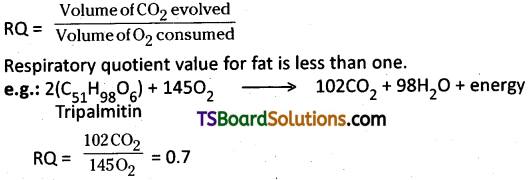
Question 11.
What is oxidative phosphorylation?
Answer:
Synthesis of ATP from ADP and iP coupled to electron transport from substrate to molecular oxygen is called oxidative phosphorylation.
Question 12.
What is the significance of stepwise release of energy in respiration?
Answer:
Question 13.
Find the correct ascending sequence of the following, on the basis of energy released in respiratory oxidation.
a) 1 gm of fat
b) 1 gm of protein
c) 1 gm of glucose
d) 0.5 gm of protein + 0.5 gm of glucose
Answer:
Ascending order
a) 1 gm of fat
b) 1 gm of protein
c) 0.5 gm of protein + 0.5 gm of glucose
d) 1 gm of glucose
Question 14.
Name the products, respectively, in aerobic glycolysis in skeletal muscle and anaerobic fermentation in yeast.
Answer:
The product of glycolysis in aerobic skeleton muscle is — The product of anaerobic fermentation in yeast is C02 and ethanol.
Question 15.
If a person is feeling dizzy, glucose or fruit juice is given immediately but not a cheese, sandwich, which might have more energy. Why?
Answer:
Energy is released quickly in case of glucose or fruit juice, it is a quick process.
Question 16.
In a way green plants and cyanobacteria have synthesised ail the food on earth. Comment.
Answer:
Green plants and cyanobacteria prepare food materials by photosynthesis. They are producers. Consumers depend on them directly or indirectly. Thus green plants and cyanobacteria prepare food materials but not all the food on earth.
![]()
Question 17.
It is known that red muscle fibres in animals can work for longer periods of time continuously. How is this possible?
Answer:
Red muscle fibres are striated muscle. They contain large number of mitochondria which release energy. They work very speed and active for longer period but with little force. As they work, they are well developed according to Lamark’s theory. Smooth muscle fibres works more longer periods than red muscle fibres.